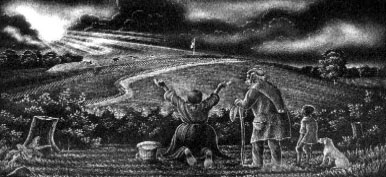Reprinted with permission from the National Park Service
See also: First Light of Freedom Monument
Roanoke Island was the setting for an historic experiment during the Civil War. Following the island’s occupation by Union forces in 1862, it became a haven for African-American families from throughout the region. Their presence prompted the Union Army to establish a Freedmen’s Colony on the northern end of Roanoke Island. This colony, similar to others established by the Union Army, gave Black Americans their first tastes of independence and freedom. However, like other sites, it was short-lived and soon faded from the pages of history.

In February 1862, Northern forces under the command of Major General Ambrose Burnside overran the Southern fortifications on Roanoke Island, gaining control of northeastern North Carolina’s strategically valuable waterways. With occupation, the Union Army was faced with the question of what to do with the enslaved people who had been sent by their enslavers to help the Confederates build fortifications on Roanoke Island.
Labeling the enslaved people as “Contraband of War”, the Union Army emancipated them, offering a new start on the island. Runaways started appearing shortly after the battle ended. Soon, hundreds of enslaved people from the interior of the state made the journey to the island. They assisted the Union troops in rebuilding forts on Roanoke and Hatteras Islands as well as New Bern and other strategic areas in North Carolina. They also served as cooks, woodcutters, teamsters, longshoremen, carpenters, and blacksmiths. Women were employed in doing mundane, menial tasks such as cooking and cleaning for Union officers. Other emancipated Black people, more courageous than most, were employed as spies, scouts, and guides and completed many invaluable missions for the Union.
By May 1863, the population situation was so acute that the Federal government seized many local lands and established a formal colony on the island. Major General John G. Foster, commander of the Department of North Carolina, instructed Army chaplain Reverend Horace James as “Superintendent of Blacks in North Carolina” to “settle the colored people on the unoccupied lands and give them agricultural implements and mechanical tools… and to train and educate them for a free and independent community.” According to Assistant Superintendent George O. Sanderson, a sergeant with the 43rd Massachusetts Infantry, the Freedmen’s Colony was laid out on the north end of the island using “compass, chart and chain, and a gang of choppers” among “the old groves of pine, gum and cypress.”
Arriving in October of 1863, Miss Elizabeth James, “...a lady sent out by the American Missionary Association,” became the first teacher in the community. She worked alone for three months, living in log cabin and working in another until other teachers followed her to the colony.
The colony continued to grow as more freedmen sought “safe haven”. A local census in 1864 reported that 2,212 black freedmen resided on the island. A church and several schools with seven teachers were established, as well as a sawmill operation. The next year, the Superintendent reported 561 houses had been built and the population had increased to 3,901. This jump occurred even after Black men were allowed to join the Union Army. Of nearly 4,000 North Carolina enlistees, over 150 men were recruited from the Roanoke Island community alone.
At the end of the war, a government order restored all lands that were confiscated by the Union Army back to the original owners. The Black residents on Roanoke Island failed to receive the rights and privileges to their homesteads promised by the government when they established the colony. Further government orders that reduced food rations and other necessities of life ushered the beginning of the end. The colony’s population declined by half from 1865 to 1866 as residents left to seek a new life elsewhere. In November of 1866, Major General John C. Robinson, Assistant Commissioner for Freedmen’s Affairs in North Carolina, feared that a “great destitution” would befall the occupants of the colony, due to the poor quality of the soil. Robinson “made arrangements for the transportation of these people from the island,” as he believed that great numbers of Freedmen would be forced to leave. By late 1866, the Freedmen’s population had dwindled to a few families and, by 1867, the colony was officially decommissioned.
The Freedmen’s Colony on Roanoke Island never became the self-sufficient community its planners envisioned. Its isolation and the transfer into the army of most of the working men made the residents more and more dependent on the government for support. It did, however, provide homes for the families of soldiers, brought education for the first time to the colony’s residents, and gave them renewed sense of hope. Furthermore, while most of the freedmen returned to the mainland, many descendants still live, work and raise their families on Roanoke Island today. While the Freedmen’s Colony is not as well known as another unsuccessful colony on these same shores, its contribution to the betterment of the Black North Carolinians in particular and American society in general should not be overlooked.